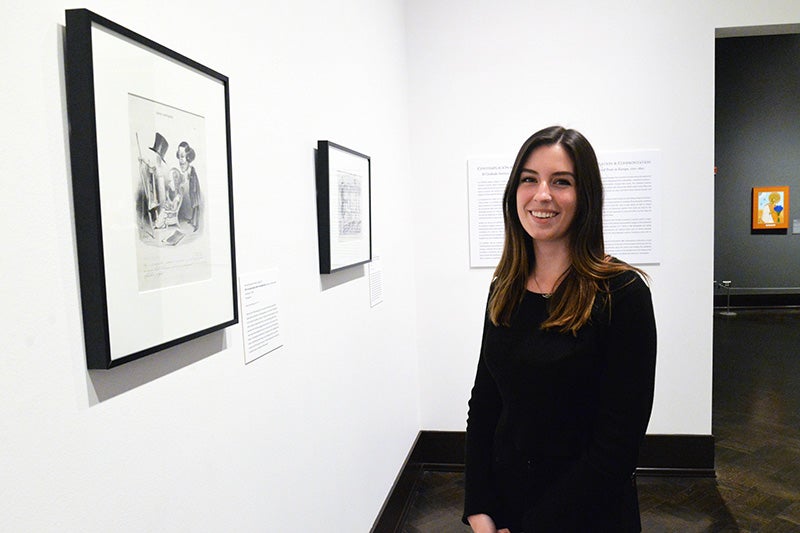Chyna Bounds was researching her master’s thesis on British satirical artists and their inventive critiques of political figures when the Jordan Schnitzer Museum of Art provided her an opportunity to curate an exhibit of European satirists.
JSMA associate curator June Black had hired Bounds for an internship at the museum and soon learned of Bounds’ fondness for satirical prints. Black introduced her to the various prints within the JSMA’s permanent collection, including Francisco Goya, William Hogarth, and other European satirists infamous for lambasting political figures and challenging the status quo.
The museum’s collection included a recently acquired work of James Gillray’s—entitled Wierd [sic] Sister, Ministers of Darkness, Minions of the Moon (1791)—that dovetailed especially well with Bounds’ area of research. Her master’s thesis focuses on British satirical printmakers Gillray and George Cruikshank, whose work critiqued the British and French governments. The 1791 Gillray print portrays Britain’s Secretary of State Henry Dundas, Prime Minister William Pitt the Younger, and Lord Chancellor Edward Thurlow clearly modeled after the witches of Shakespeare’s Macbeth.

Above: Graduate student Chyna Bounds curated the exhibition Contemplation & Confrontation: The Satirical Print in Europe, 1750-1850 at the JSMA through December 27. Bounds is a graduate student in the Department of the History of Art and Architecture. Photo by Chloe Peterson.
“I hope to work as a curator of prints and drawings, and it was a lucky coincidence that this new Gillray print emerged,” says Bounds. “The rest of the exhibition pretty much formed around the Gillray print. We looked at other satirical images in the JSMA collection and chose which ones we thought would be appropriate to exhibit as a group.” The exhibition focuses on satire from a particular era (1750-1850) rather than serving as a comprehensive survey.
Contemplation & Confrontation: The Satirical Print in Europe, 1750-1850 is on display at JSMA until December 27. It is the first exhibition at JSMA to include Gillray’s 1791 work.
Pulling from the JSMA’s collection of satirical prints, Bounds and Black carefully selected the most suitable pieces to showcase together. Bounds also sought guidance from JSMA curator of Western art Johanna G. Seasonwein.
“With Contemplation & Confrontation we gave [Chyna] the opportunity to curate an exhibition from start to finish,” Black says. “I spent several days with her in our collections storage areas, showing her a broad selection of works that related to her interests. From there, she came up with a more concrete theme and I worked with her to select a final group of works from the permanent collection.”
The exhibit features Spanish artist Francisco Goya’s prints from his series Los Caprichos (The Whims). This includes Que viene el coco (Here Comes the Bogeyman), which criticizes the deceit of adultery; El Vergonzoso (The Shamefaced One), which comments on the ugliness of society and the theme of sexual thievery; and ¿No hay quien nos desate? (Is there no one to untie us?), which depicts a couple tied together with a rope, in reference to arranged marriages under the rule of the Catholic Church.
“Many images against the bourgeoisie and political figures were being produced in mass amounts [between 1750-1850],” says Bounds, a graduate teaching fellow in the Department of the History of Art and Architecture.
![Gillray's 1791 work Wierd [sic] Sister, Ministers of Darkness, Minions of the Moon](/sites/default/files/images/news/2015/gillrayweirdsisterssm.jpg)
Above: Gillray's 1791 work Wierd [sic] Sister, Ministers of Darkness, Minions of the Moon caricatures British prime minister William Pitt the Younger, Lord Chancellor Edward Thurlow, and Secretary of State for Home Affairs Henry Dundas. The moon shows Queen Charlotte on the illuminated side and King George III on the dark side. This print is a parody of artist Henry Fuseli’s painting of the three witches in Macbeth. (British, 1757-1815). Published by Hannah Humphrey, 23 December 1791. Hand-colored etching and aquatint, 9 ¾ x 13 ¾ inches. Gift of David Hilton; 2012:17.7 Image courtesy Jordan Schnitzer Museum of Art. See more here.
The Stage of Cruelty series from Hogarth is also on display. Hogarth created the visceral sequence of prints from violent scenes he witnessed regularly in London. The prints depict fictional character Tom Nero as the embodiment of an upper-class London male in that era. Each print shows Nero involved in some form of vice—inflicting cruelty upon animals and humans alike, partaking in robbery and murder—until he reaches own undoing at the gallows.
Hogarth printed the series on cheap paper rather than woodcuts, which allowed for greater detail in the complicated scenes that unfold, and made them inexpensive enough for mass production. This printmaking method was popular among artists in the 18th and 19th centuries, as these prints were inexpensive to create and easy to distribute.
As a result, an artist’s countercultural ideas that challenged the predominant ethos of the Church, morality, and the government could easily be disseminated to poorer populations.
“Since these prints primarily criticize the royal [and] governmental figures and the elite or upper class, the artists wanted them to be available to others who shared the same disdain toward the upper class,” Bounds says. “These themes would have resonated with the lower classes.”
The historical instances of provocative works parallel modern-day satire found in political cartoons and elsewhere, Bounds points out.
“These artists criticized the government or royalty … and that type of satire is prevalent in contemporary works that criticize presidential candidates and foreign leaders [today],” she says.
Bounds’ internship includes writing wall labels for various artworks, assisting with artist interviews, providing class tours of exhibits, and writing acquisition proposals to expand the museum’s collection.
She also serves as student liaison for the JSMA’s Collections Committee, a board of JSMA curators and UO art and art history professors who discuss the museum’s collection and the potential for future acquisitions.
